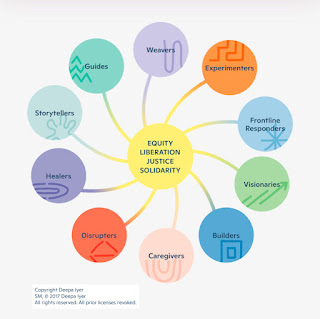Finding Your Place in the Work of Justice
It’s easy to think activism comes in only two flavors: shouting in the streets or despairing at home. But the truth is, there’s a whole matrix of ways to be engaged - ways that honor both your capacity and the needs of the world.
Where do you fit? That depends. You need to ask yourself two questions:
1. Am I over-risking or over-functioning? Are you burning out, running on fumes, taking on more than is sustainable? Are you showing up in ways that exhaust you rather than energize you? Activism that neglects joy isn’t sustainable. Comfort the afflicted, including yourself.
2. Am I avoiding necessary conflict? Are you being “nice” when you need to be truthful? Are you leaning on spiritual bypassing, hoping love and light will make injustice disappear? Sometimes, transformation requires tension. If you have privilege – whiteness, cisness, maleness, class privilege – it may be time to take more risks. Afflict the comfortable – even if that’s you.
Compassion is Key
For those being directly targeted in this political climate: your safety comes first. Prioritizing your well-being isn’t a failure of activism, it’s often the most radical act you can take. Asking for help, leaning on community, and ensuring you have what you need to survive is sacred work. You are not required to be a martyr.
And if you are in a position to aid or shelter someone in need? Do so. The question is always: Who is my neighbor? The person in need is my neighbor. Maybe that means literally standing between them and the cameras (or the hecklers) at a rally. Maybe it means donating to Pink Haven, helping trans people relocate to safety. Maybe it means checking in on your friends, showing up with a meal, offering a ride. It always means directly asking, “How can I Help?”
What Can I Do?
Joanna Macy describes three dimensions of “The Great Turning” toward a life-sustaining society:
- Holding actions: Directly interrupting harm: protests, advocacy, legal action.
- Structural change: Creating alternatives: building new systems and ways of being.
- Shift in consciousness: Changing how we see the world: spiritual work, education, cultural transformation.
No single one of these is enough. We need all three. You can read more about this framework at The Work That Reconnects.
And within each, there are even more ways to engage. Deepa Iyer maps out ten roles people take in movements: builders, caregivers, disrupters, visionaries, and more. The work is vast, and you have a place in it.
Your Place in the Work of Justice
There’s no single “right” way to engage. But there is a right way for you, right now. And as you grow, your role may shift. What matters is that you pay attention: to yourself, to your community, to the world. Move toward the work that calls to you, and let it change you.
Justice isn’t a solo act. It’s a living, breathing movement, and we all have a part to play.
You are whole, holy, and worthy,
Rev. Amy
Tips:
- Don’t reinvent. There are organizations that have been doing this work well, who can guide you. See for example, the list on “Human Rights Careers”, Side With Love, LWV.org, National Congress of American Indians (NCAI), Interfaith Movement for Human Integrity, Climate Justice Alliance (CJA), Building Movement Project.
- Dance, sing, attend to beauty.
- Notice the folks who are taking action – get inspired and share your inspiration. (Pink News, MeidasTouch)
- Build relationships.
- Connect with the sacred, wherever and however you can.



No comments:
Post a Comment